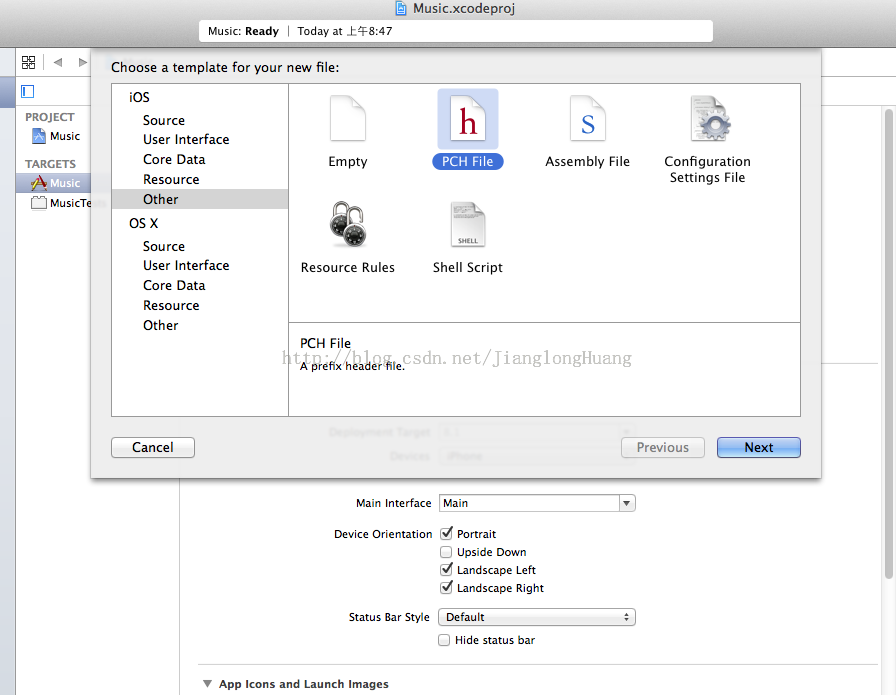corePlot使用技巧及iOS內存優化之道
corePlot 使用技巧:
設置內邊距:
graph.plotAreaFrame.paddingLeft +=5;
graph.plotAreaFrame.paddingTop +=5;
graph.plotAreaFrame.paddingRight +=5;
graph.plotAreaFrame.paddingBottom +=17.5;
禁止縮放:(兩指捏擴動作)
[selfsetAllowPinchScaling:NO];//禁止縮放
設置坐標只能按照X軸橫向滑動:(其他方向請自行理解)
plotSpace.yRange = [CPTPlotRangeplotRangeWithLocation:CPTDecimalFromInt(0)length:CPTDecimalFromFloat(1)];
plotSpace.globalYRange = [CPTPlotRangeplotRangeWithLocation:CPTDecimalFromInt(0)length:CPTDecimalFromFloat(1)];
plotSpace.xRange = [CPTPlotRangeplotRangeWithLocation:CPTDecimalFromInt(1)length:CPTDecimalFromFloat(1)];
plotSpace.globalXRange = [CPTPlotRangeplotRangeWithLocation:CPTDecimalFromInt(0)length:CPTDecimalFromFloat(2)];
自定義軸label:
x.axisLabels = [self buildLabelTitle];
x.labelingPolicy = CPTAxisLabelingPolicyNone;//當設置這個Policy之後,坐標軸label及背景線tick都需要自己繪制,否則顯示為空,請不要過度驚慌
x.minorTickLocations = [NSSetsetWithArray:locationLabels];
- (NSMutableSet*)buildLabelTitle
{
NSMutableSet *newAxisLabels = [NSMutableSetset];
CPTMutableTextStyle *textStyleB = [CPTMutableTextStyletextStyle];
textStyleB.color = [CPTColorcolorWithComponentRed:CPTFloat((float)0x09/0xFF)green:CPTFloat((float)0x31/0xFF)blue:CPTFloat((float)0x4A/0xFF)alpha:CPTFloat(1.0)];
int n = 1;
for ( NSUInteger i =30; i > 0; i--)
{
CPTAxisLabel *newLabel = [[CPTAxisLabelalloc] initWithText:@“這裡是內容”
textStyle:textStyleB];
newLabel.tickLocation =CPTDecimalFromUnsignedInteger(n++);
newLabel.offset = 5;
[locationLabels addObject:[NSNumber numberWithFloat:(n-1) -0.25]];
[locationLabels addObject:[NSNumber numberWithFloat:(n-1) +0.25]];
[newAxisLabels addObject:newLabel];
[newLabel release];
}
return newAxisLabels;
}
刷新圖表內容:
[[bar1graph] reloadData];
組織數據源:
[m_SO2OnlineCaddObject:[NSMutableDictionarydictionaryWithObjectsAndKeys:x, @"x", y,@"y", nil]];
if (tmpY> MAX_data)
{
MAX_data = tmpY;
}
使用數據源:
if ([(NSString*)plot.identifierisEqualToString:kBar1])
{
switch (fieldEnum)
{
caseCPTBarPlotFieldBarLocation:
number = [[[m_SO2OnlineCobjectAtIndex:index] valueForKey:@"x"]doubleValue];
break;
caseCPTBarPlotFieldBarTip:
number = [[[m_SO2OnlineCobjectAtIndex:index] valueForKey:@"y"]doubleValue]/ MAX_data;
break;
default:
break;
}
}
這裡要記錄MAX_data的原因是這裡最好使用真實數據的相對數據,否則當數據值很大的時候會消耗corePlot的性能導致圖形加載很慢。
用延遲函數去調用數據初始化可以提高加載速度:
[selfperformSelector:@selector(initPlotData)withObject:nilafterDelay:0.2];
計算日期的簡單方法:
NSDateComponents* comps = [[NSDateComponentsalloc]init];
[comps setDay:-i];
NSDate *newDate = [[NSCalendarcurrentCalendar] dateByAddingComponents:compstoDate:[NSDate date]options:0];
--------------------------------------------------------
iOS內存優化及排查方法
1.IBOutlet 對象需要release
2.不停的往UIView,特別是UIScrollView上add相同SubView。一定要記得清除之前的SubView,並且在dealloc函數中執行該方法
for (UIView* sbViewin scrvBg.subviews)
{
[sbView removeFromSuperview];
}
這裡還有個獲得subView的小技巧:
[subView setTag:300];
subView = [self.viewviewWithTag:300]
3.dealloc不一定會被調用,所以可以自己手寫一個myRelease方法,當退出該界面的時候手動調用release需要釋放的對象,並且將其置為nil。
4.記住,如果你不太明白UIView的drawRect的調用時機,千萬不要輕易往drawRect裡寫代碼,特別是沒有立即release的對象。很容易在這裡因為多次調用了drawRect而沒有release該對象導致內存溢出。
5.檢查內存洩漏最好的工具是xCode,當然不是說xCode工具排查完了就OK了。我們發現xCode只能檢查明顯的代碼級別洩漏,而像上面第四點因為多次調用某個函數卻沒有配對release的邏輯性洩漏是排查不出來的,只能通過代碼閱讀排查。
我這裡能給出的經驗就是,alloc的對象應該立即release。如果該對象不能立即release,必須保證alloc和release必須配對調用,特別要留意那些可以多次調用且包含alloc卻未被及時release的函數。四個字概括“非常危險”!
6.屬性對象不要用Self.來alloc它,例如:
self.my_arr =[[NSArray alloc]init]; ---------- 錯誤!
NSArray *tmpArr = [[NSArray alloc]init];
self.my = tmpArr;
[tmpArr release]; ---------- 正確
- iOS9與XCode7中不克不及應用http銜接的疾速處理方法
- xcode8 封閉掌握台不打印不信息的處理辦法(圖文詳解)
- 史上最具體的CocoaPods裝置教程(圖文)
- IOS Xcode中快捷鍵年夜全
- iOS中處理Xcode 8掌握台亂碼的方法
- IOS開辟之適配iOS10及Xcode8的留意點
- xcode8提交ipa掉敗沒法構建版本成績的處理計劃
- IOS 開辟自界說條形ProgressView的實例
- XCode 加速編譯鏈接速度的辦法
- 2016 cocoapods的裝置和應用辦法和版本進級碰到的成績
- IOS 陀螺儀開辟(CoreMotion框架)實例詳解
- 進修iOS自界說導航掌握器UINavigationController
- Xcode 8打印log日記的成績小結及處理辦法
- iOS10 適配和Xcode8設置裝備擺設總結
- iOS Xcode8更新後輸入log日記封閉的辦法




